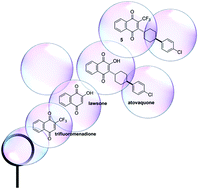Exploring the trifluoromenadione core as a template to design antimalarial redox-active agents interacting with glutathione reductase†
Abstract
Menadione is the 2-methyl-1,4-naphthoquinone core used to design potent antimalarial redox-cyclers to affect the redox equilibrium of Plasmodium-infected red blood cells. Exploring the reactivity of fluoromethyl-1,4-naphthoquinones, in particular trifluoromenadione, under quasi-physiological conditions in NADPH-dependent glutathione reductase reactions, is discussed in terms of chemical synthesis, electrochemistry, enzyme kinetics, and antimalarial activities. Multitarget-directed drug discovery is an emerging approach to the design of new antimalarial drugs. Combining in one single 1,4-naphthoquinone molecule, the trifluoromenadione core with the alkyl chain at C-3 of the known antimalarial drug atovaquone, revealed a mechanism for CF3 as a leaving group. The resulting trifluoromethyl derivative 5 showed a potent antimalarial activity per se against malarial parasites in culture.


 Please wait while we load your content...
Please wait while we load your content...